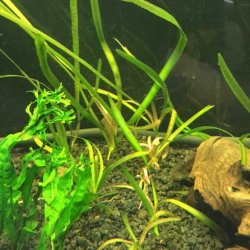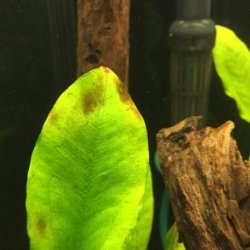Cramer719 said:
Thank you so much for the help. The tank is 24" tall and 48" long. I figured with it being a taller tank I should get HO T5's(so yes they are HO). I have stopped dosing. I'll wait and see I guess. Do you think the substrate could be causing it? The fluorite was recommended to me so I just went with it. Would too much light kill the Val's like that?
Also what floating plants do you suggest. I had some Duckweed but my barbs like to eat it, maybe I just need a larger bunch.
Diagnosing specific plant issues is not easy, because so often there are related issues. As a simple example, calcium deficiency can appear as an excess of iron, even though iron may not be more than what is required.
I have known too intense lighting to cause plants to yellow and slowly give out. But usually algae will be increasing along with it. So this is likely not the only issue.
If I were to suggest lighting for this tank, it would be dual T8 using two 48-inch tubes. But as you have the T5, I think it can work with some tweaking. Reducing the duration daily is one way, and I would start with 8 hours. If this, plus the other suggestions combined, does not seem to help, you can reduce a further hour or two.
One question on your light fixture: can you remove one tube and have the other still light? Some will, some won't, depending upon how they are wired. If you can, removing one tube would probably work and you could get a good 6700K daylight tube. Just another option if it can work. And something else occurs to me...will it take NO (= normal output) tubes in place of HO? NO T5 are basically equivalent in intensity to the same type of tube in T8. NO tubes are not that common, but in the USA you might be able to track them down, if your fixture will take them.
Floating plants that have substance (as opposed to duckweed) is what will work best for you. Water Sprite (
Ceratopteris cornuta), Water Lettuce (
Pistia stratiotes), Frogbit (
Limnobium laevigatum) are three I have and all are lovely plants. You can "Google" the scientific names and see photos. Some of the stem plants do well left floating; my favourite is Brazilian Pennywort (
Hydrocotyl leucocephala). Some have luck with Wisteria (
Hygrophila difformis). The Red and Green Tiger Lotus (
Nymphaea species) will produce floating leaves similar to a water lily. Any of these will cover the surface if allowed to, and I would aim for that.
Flourite is something I tried four years ago in my 70g, and I had it as the sole substrate for two years before I tore the tank down and discarded the Flourite in the back garden. I did not notice any improvement in plant response compared to plain fine gravel or play sand, which I have in my other six tanks and now after two years with play sand in the 70g the plants are just as they were previously. As you have it, keep it, it can't do any harm, except to substrate fish like loaches and cories if you have the gravel; the sand I understand is better for these fish. My Flourite gravel was rough, more than I realized, and I had to remove my cories after they developed barbel degeneration and even worse, damaged mouths. They have fortunately all recovered with sand.
Don't give up, there is a solution and we will find it. It takes a few weeks after any changes are made for the plant response to show, so be patient. I am suggesting several changes to start with, as I think these need addressing; but after a few weeks, if things are not improving, any further changes I suggest will be slow and one at a time to give the plants time to adjust.
Byron.



